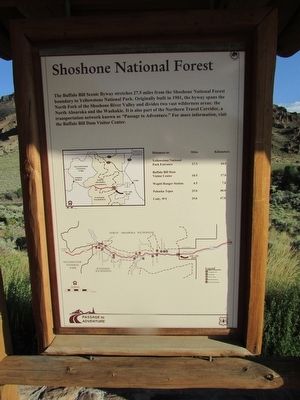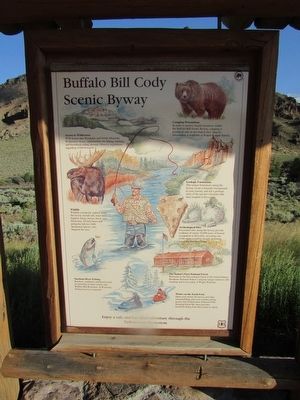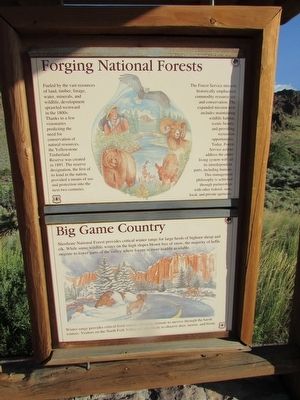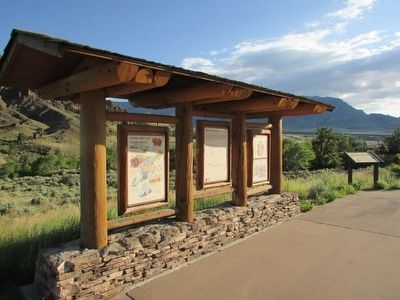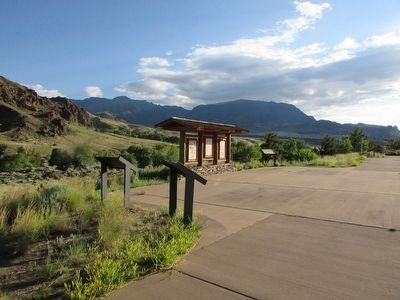Wapiti in Park County, Wyoming — The American West (Mountains)
Shoshone National Forest
The Buffalo Bill Scenic Byway stretches 27.5 miles from the Shoshone National Forest boundary to Yellowstone National Park. Originally built in 1901, the byway spans the North Fork of the Shoshone River Valley and divides two vast wilderness areas: the North Absaroka and the Washakie. It is also part of the Northern Travel Corridor, a transportation network known as “Passage to Adventure.” For more information, visit the Buffalo Bill Dam Visitor Center.
< Second Marker : >
Buffalo Bill Cody Scenic Byway
Access to Wilderness
With access into Washakie and North Absaroka Wilderness Areas, opportunities for hiking, hunting, and horseback riding abound. Observe regulations regarding wilderness use.
Wildlife
Wildlife commonly sighted along the byway include elk, mule deer, bighorn sheep, moose, bison, and black bear. Grizzly bears and peregrine falcons, both threatened species, also frequent the area.
Shoshone River Fishing
Rainbow, cutthroat, and brown trout are plentiful in these waters and Buffalo Bill Reservoir. A Wyoming fishing license is required.
Camping Precautions
In order to protect fragile resources within the Buffalo Bill Scenic Byway, camping is permitted only in developed sites. Specific information is available at Wapiti Ranger Station.
Geologic Formations
The unique formations along the byway create a dramatic background to your journey and tell a geologic story of the ancient volcanoes that once erupted in this region.
Archaeological Sites
Excavated sites along the byway provide evidence of nearly 10,000 years of human occupation in this valley, revealing one of the most complete records of human use of the Northern Plains.
The Nationís First National Forest
Welcome to the first national forest in the United States! Shoshone National Forestís original ranger station is still standing and in use today at Wapiti Wayside.
Winter on the North Fork
Open year round, the byway provides snowmobiling and cross country skiing access into Yellowstone National Park. Sleeping Giant Ski Area provides downhill skiing from November to April.
< Third Marker : >
Forging National Forests
Fueled by the vast resources of land, timber, forage, water, minerals, and wildlife, development sprawled westward in the 1800s. Thanks to a few visionaries predicting the need for conservation of natural resources, the Yellowstone Timberland Reserve was created in 1891. The reserve designation, the first of its kind in the nation, provided a means of use and protection into the next two centuries.
The Forest Service mission historically emphasized commodity resource use and conservation. The expanded mission now includes maintaining wildlife habitat, scenic beauty, and providing recreation opportunities. Today, Forest Service actions address the entire living system with all its interdependent parts, including humans. This management philosophy is achieved through partnerships with other federal, state, local, and private agencies.
Big Game Country
Shoshone National Forest provides critical winter range for large herds of bighorn sheep and elk. While some wildlife winter on the high slopes blown free of snow, the majority of herds migrate to lower parts of the valley where forage is more readily available.
Winter range provides critical food sources allowing animals to survive through the harsh winters. Visitors on the North Fork Valley are also likely to observe deer, moose, and bison.
Erected by Shoshone National Forest.
Topics. This historical marker is listed in these topic lists: Animals • Environment • Horticulture & Forestry • Natural Features.
Location. 44° 27.634′ N, 109° 31.559′ W. Marker is in Wapiti, Wyoming, in Park County. Marker is on U.S. 20, on the right when traveling west. Marker is located at the eastern boundary of Shoshone National Forest. Touch for map. Marker is in this post office area: Wapiti WY 82450, United States of America. Touch for directions.
Other nearby markers. At least 6 other markers are within 4 miles of this marker, measured as the crow flies. Protection Proves Profitable (here, next to this marker); A Burning Need (here, next to this marker); Is This Forest Healthy? (here, next to this marker); Touch the Past (approx. 2.9 miles away); Solving the Prehistoric Puzzle (approx. 2.9 miles away); Absaroka Volcanic Field (approx. 3.2 miles away).
Credits. This page was last revised on June 16, 2016. It was originally submitted on September 25, 2015, by Bill Coughlin of Woodland Park, New Jersey. This page has been viewed 321 times since then and 7 times this year. Photos: 1, 2, 3, 4, 5. submitted on September 25, 2015, by Bill Coughlin of Woodland Park, New Jersey.
